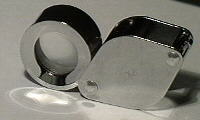

Cheap & Easy Microscopy
Not quite certain if Microscopy is for you? Don't want to lash
out a hundred pounds for a starter microscope to find out? Well
here's a way to become a 'scoper' for less than a tenner (10
pounds UK).
A range of high-quality compound pocket magnifiers are available, from 2x to 15x, which can be used in a variety of ways. I recently purchased the 8x magnifier shown above for approx. 10 UK pounds and if I had looked around, I could probably have paid less for it.
Magnifiers: the good and the bad
I'm sure everyone has seen the cheap magnifiers, often plastic
instead of glass, and virtually useless for any real close-up
study. Avoid these at all costs. You should be looking to pay
between 6.00 to 18.00 pounds for the type of magnifier you need
to see things without distortion and blurred detail. I have
provided a few places at the end of this article where you will
be able to purchase good magnifiers at a reasonable price.
Some magnifiers come with 2 or even 3 different magnification glasses. Most of them can be folded so that the glass optic is slid into a case or housing to protect it from getting scratched in your pocket. I would recommend, as a first purchase, a simple 8x single compound magnifier like the one shown above.
What to look at
You will be surprised by how much greater detail becomes visible
when viewing almost anything under the 8x magnifier. Take your
kids along for a walk on the local common or just step out into
you garden. Find any tiny flower, blossom, slow-moving insect,
lichen, leaf, nettle, grass, and take a look at it through your
magnifier. Most 'scopers' wouldn't go for a walk without one.
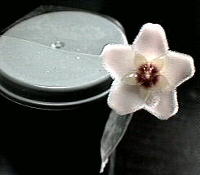 I picked this tiny
wax-like flower from one of our house plants. It measures only 17
mm across at its widest part (tip of petal to tip of petal). It
may appear bigger than this on your monitor but you can see a
film container, or at least, its cover to the left. This will
enable you to gauge relative size. The container is the little
plastic 'can' you get 35 mm photographic film in.
I picked this tiny
wax-like flower from one of our house plants. It measures only 17
mm across at its widest part (tip of petal to tip of petal). It
may appear bigger than this on your monitor but you can see a
film container, or at least, its cover to the left. This will
enable you to gauge relative size. The container is the little
plastic 'can' you get 35 mm photographic film in.
I cannot remember the name of the plant but it is a tropical one with an extraordinary appearance: the whole plant, including the stem, leaves, and flowers, look as though they are made of wax.
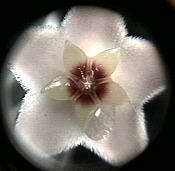 This is what it looks
like through my 8x magnifier. It is very beautiful and more
detail becomes visible. This flower is probably a bad choice
because even magnified it still looks fairly featureless compared
to most other types of small flowers.
This is what it looks
like through my 8x magnifier. It is very beautiful and more
detail becomes visible. This flower is probably a bad choice
because even magnified it still looks fairly featureless compared
to most other types of small flowers.
I have reduced the detail of the image slightly in the
process of making it ready for the web. This was due to the need
to keep file sizes small, otherwise you will be waiting forever
to see these pages.
Here is another tiny flower from another house plant. The yellow centre is just 6 mm across.
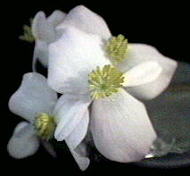
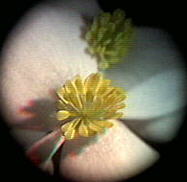
Right image is with 8x magnifier.
Turning the magnifier into a low power microscope
Most families today have a home video camera (a camcorder) and
nearly every camera comes equipped with zoom capability. My
camera zooms at up to 11x. By using your camcorder on zoom and
filming through the 8x magnifier lens, you can effectively make
video films of microscopic subjects. Powers close to 80x
magnification are achievable although the quality will be less
than what you would get with a real microscope.
 This is a sample
taken from a video film I recorded using this method. I stuck the
flower onto the side of a film can with sticky-tape and used a
'helping-hand' to hold the magnifier; this is a small tool,
widely available for a few pounds, which has a clip mounted on a
multi-jointed arm. I'll show you one in a moment.
This is a sample
taken from a video film I recorded using this method. I stuck the
flower onto the side of a film can with sticky-tape and used a
'helping-hand' to hold the magnifier; this is a small tool,
widely available for a few pounds, which has a clip mounted on a
multi-jointed arm. I'll show you one in a moment.
The camera is mounted on a tripod and everything is lined up so the camera and lens are in a line, with the lens of the magnifier parallel to the lens of the camera. By zooming and focusing the camera, and moving the target subject slightly forwards and backwards behind the magnifier, a focused image is soon obtained.
This arrangement 'models' the action of a real microscope with your camera substituting for an eyepiece lens and the magnifier acting as an objective.
A trip to the sea-side
The next time you go to the coast for the day, take your 8x
magnifier along. The beaches are littered with tiny shells left
behind by the creatures that once lived in them. You will be able
to examine the fine structure and detail of these beautiful
constructions. I'm sure if you invest a few pounds in purchasing
your own compound magnifier, you will get a life-time's use and
pleasure from it.
Props?
The image below shows the things used on my work bench to take
these images. From left to right: my cup of tea (its shadow),
a tiny flower stuck to a film can, the 8x magnifier, the 'helping
hand' (holding the magnifier. You might also notice my own
reflection caught in the shiny metal surface of the magnifier
case.
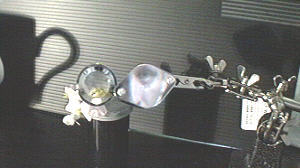
Next month I'll try and show you some other things to study with your own 8x magnifier. So you have a few weeks to go out and purchase one. Here are a few places you can try to get a good one from at a reasonable price in the UK. If any of you know similar sources in your own country, let me know by email and I will add them to the list below.
Magnifiers: sources
Brunel Microscopes Ltd. Unit 8, Pickwick Workshops, Park Lane,
Corsham, Wilts. SN13 OHN.
Tel: 01249 701601 See
Brunel Catalogue
A US reader kindly took the trouble to inform us that: 'In Boston, Massachusetts Bausch & Lomb Hastings triplets can be purchased at Stoddards. I own the 7X and the 14X and am very pleased with then. However they carry 7X, 10X,14X, and 20X. Prices range between $45 and $60 US.'
Until next month... Maurice
Read the second article in this series 8X More showing more fascinating close-ups of the world around us.
Micscape Editor's Note
The July 'Walk on the
Wildside' with Dave Walker also shows a few more examples of
what you can see in summer with a 5-10X hand lens. We're all keen
devotees of the wonders that can be seen under a hand lens, so I
hope we are passing on our infectious enthusiasm!
Please report any Web problems
or offer general comments to the Micscape Editor,
via the contact on current Micscape Index.
Micscape is the on-line monthly
magazine of the Microscopy UK web
site at Microscopy-UK